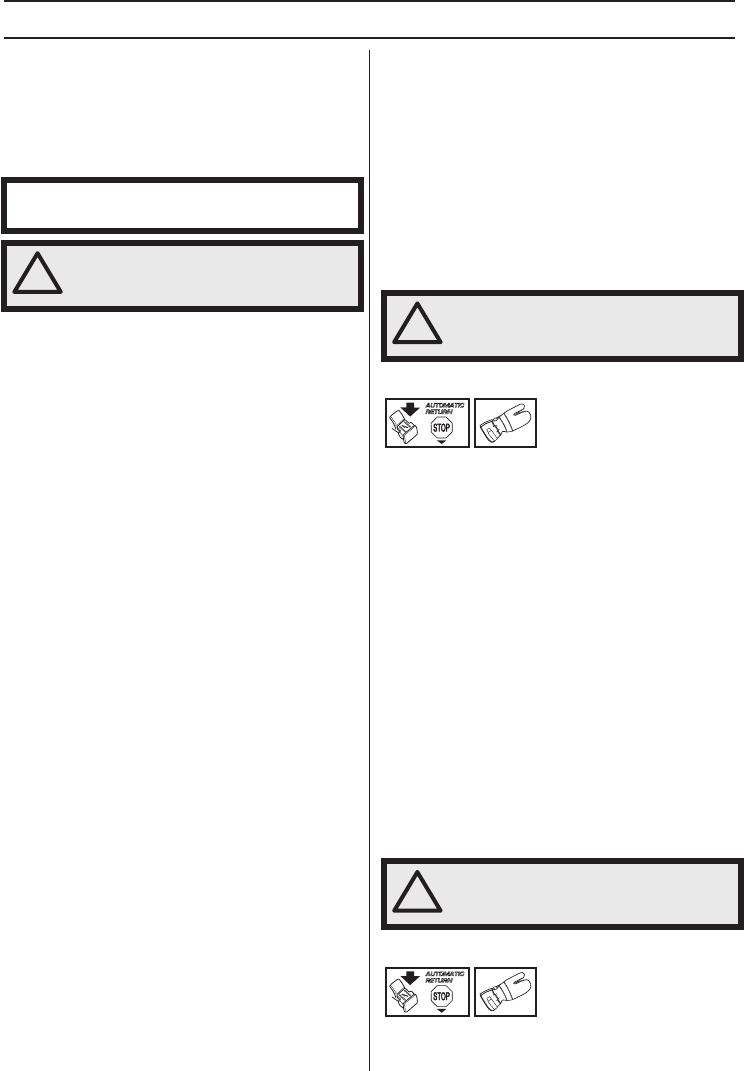
GENERAL SAFETY PRECAUTIONS
English – 15
1153135-49 Rev.1 2009-12-29
Bar
The smaller the tip radius the lower the chance of
kickback.
Chain
A chain is made up of a number of links, which are
available in standard and low-kickback versions.
Some terms that describe the bar and chain
To maintain the safety features of the cutting equipment,
you should replace a worn or damaged bar or chain with
a bar and chain combinations recommended by
Husqvarna. See instructions under the heading Technical
Data for a list of replacement bar and chain combinations
we recommend.
Bar
• Length (inches/cm)
• Number of teeth on bar tip sprocket (T).
• Chain pitch (inches). The spacing between the drive
links of the chain must match the spacing of the teeth
on the bar tip sprocket and drive sprocket.
(14)
• Number of drive links. The number of drive links is
determined by the length of the bar, the chain pitch
and the number of teeth on the bar tip sprocket.
• Bar groove width (inches/mm). The groove in the bar
must match the width of the chain drive links.
• Chain oil hole and hole for chain tensioner. The bar
must be matched to the chain saw design.
(15)
Chain
• Chain pitch (inches) (14)
• Drive link width (mm/inches) (16)
• Number of drive links. (17)
Sharpening your chain and adjusting
depth gauge setting
General information on sharpening cutting teeth
• Never use a blunt chain. When the chain is blunt you
have to exert more pressure to force the bar through
the wood and the chips will be very small. If the chain
is very blunt it will produce wood powder and no chips
or shavings.
• A sharp chain eats its way through the wood and
produces long, thick chips or shavings.
• The cutting part of the chain is called the cutter and
consists of a cutting tooth (A) and the depth gauge
(B). The cutters cutting depth is determined by the
difference in height between the two (depth gauge
setting).
(18)
When you sharpen a cutting tooth there are four important
factors to remember.
1 Filing angle (19)
2 Cutting angle (20)
3 File position (21)
4 Round file diameter
It is very difficult to sharpen a chain correctly without the
right equipment. We recommend that you use our file
gauge. This will help you obtain the maximum kickback
reduction and cutting performance from your chain.
(22)
See instructions under the heading Technical data for
information about sharpening your chain.
Sharpening cutting teeth
To sharpen cutting teeth you will need a round file and a
file gauge. See instructions under the heading Technical
data for information on the size of file and gauge that are
recommended for the chain fitted to your chain saw.
• Check that the chain is correctly tensioned. A slack
chain will move sideways, making it more difficult to
sharpen correctly.
• Always file cutting teeth from the inside face. Reduce
the pressure on the return stroke. File all the teeth on
one side first, then turn the chain saw and file the teeth
on the other side.
• File all the teeth to the same length. When the length
of the cutting teeth is reduced to 4 mm (5/32") the
chain is worn out and should be replaced.
(23)
General advice on adjusting depth gauge setting
• When you sharpen the cutting tooth (A) the depth
gauge setting (C) will decrease. To maintain optimal
cutting performance the depth gauge (B) has to be
filed down to achieve the recommended depth gauge
setting. See instructions under the heading Technical
data to find the correct depth gauge setting for your
particular chain.
(24)
Adjustment of depth gauge setting
• The cutting teeth should be newly sharpened before
adjusting the depth gauge setting. We recommend
IMPORTANT! No saw chain design eliminates the
danger of kickback.
!
WARNING! Any contact with a rotating
saw chain can cause extremely serious
injuries.
!
WARNING! Departure from the
sharpening instructions considerably
increases the risk of kickback.
!
WARNING! The risk of kickback is
increased if the depth gauge setting is
too large!


















